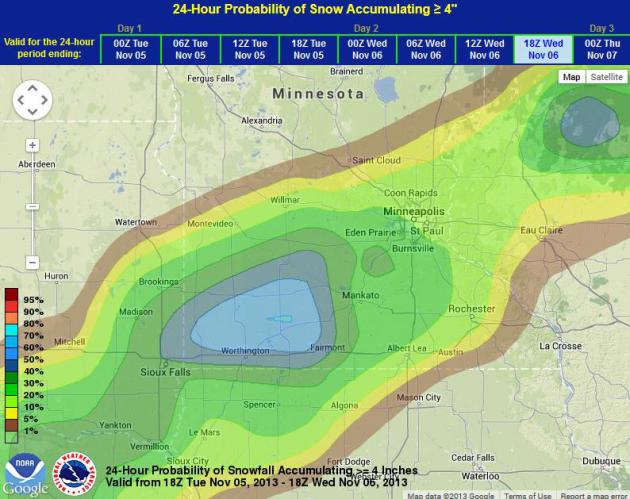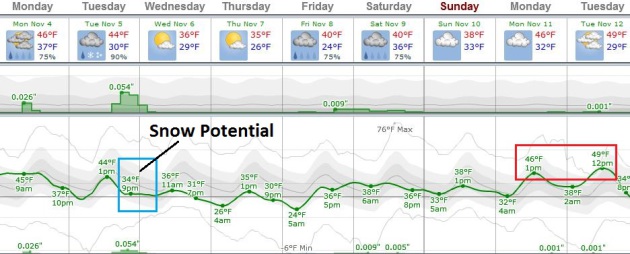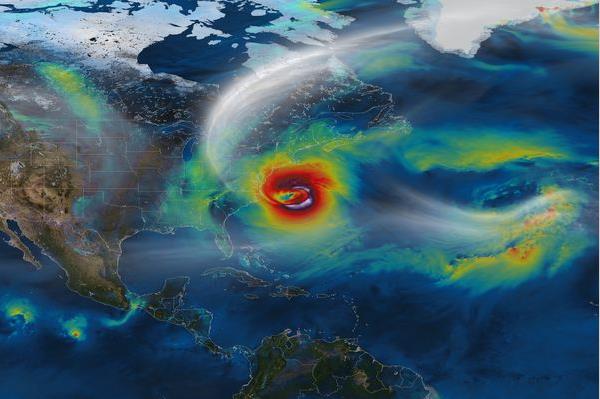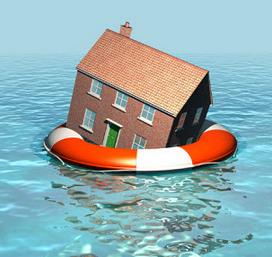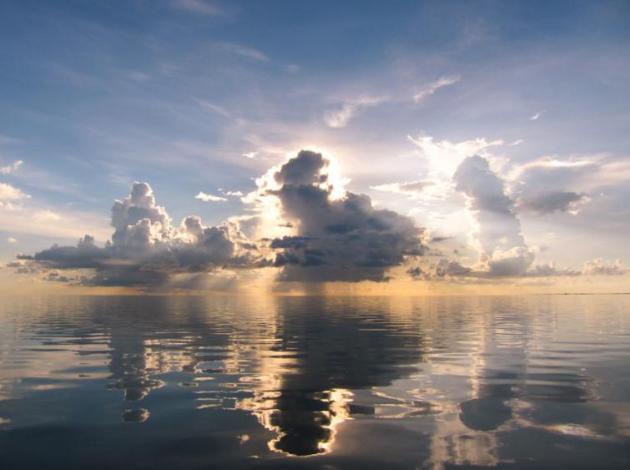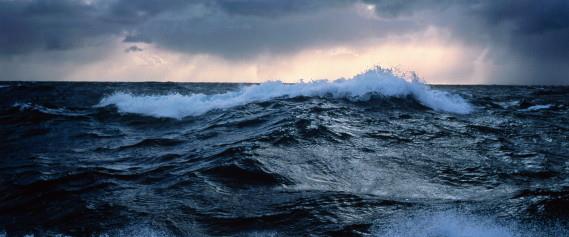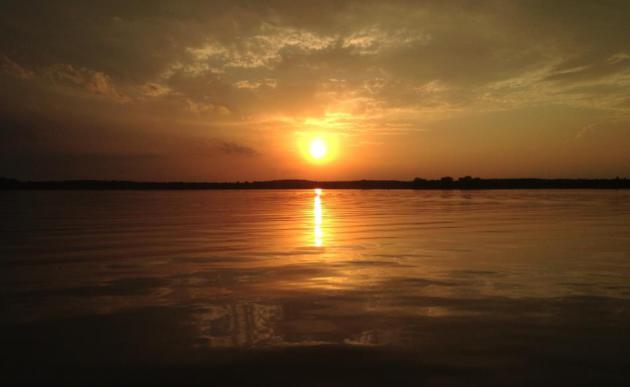What Did You Eat?
My
niece, Anna Ball, just got back from an extended stay in Italy. She
told me locals don't greet each other with "How are you?" They ask "What
did you eat?" Life revolves around food. Can't remember?
"If you can't remember what you ate it must not have been very good" Anna told me.
I'm lobbying St. Paul to replace "What do you think of this weather?" OK, don't hold your breath.
What
may be our first accumulating snow event of the winter season may
materialize from a sloppy southern storm; a cold rain Tuesday afternoon
changing to wet snow Tuesday night.
Ground temperatures are still
fairly mild, so I expect some melting on contact, but a few inches could
pile up on metro lawns; roads becoming slushy and slick after 7 PM. The
ECMWF (European) model prints out 6+ inches for southwest counties.
And so it begins.
This
is just Old Man Winter firing a warning shot across our bow. After a
couple days in the 30s midweek we thaw into the 40s; I could see a few
days above 50F next week. No sign of anything frigid just yet.
A puff of cooler air sparks a few rain showers today. Within 36 hours there will be no doubt in your mind that it's November.
What DID I eat? I'd rather focus on food.
Probability Of 4"+ Snow.
The best chance of plowable snows will come over southwestern
Minnesota, a 50-60% probability of 4" or more, based on NOAA guidance,
compared to a 20-30% risk over the Twin Cities.
NAM Solution.
I'm not buying this solution (yet). I want to see a few more runs
before I start attaching inch amounts to any Twin Cities forecast, but
the greatest potential for enough snow to shovel and plow (?) will
probably come south of the Twin Cities. Map above: NOAA.
Chilly Week - Some Moderation Next Week.
ECMWF guidance keeps highs in the 30s Wednesday and Thursday; highs
near 40F over the weekend, then well into the 40s a week from now.
Precipitation tomorrow starts as rain, with a probable changeoever to
wet snow Tuesday night. A light rain-snow shower mix is possible late
Friday into Saturday with little or no accumulation. Graph:
Weatherspark.
 Winter Hazard Awareness Week In Minnesota.
Winter Hazard Awareness Week In Minnesota.
Map above shows average annual snowfall for Minnesota, courtesy of the
Twin Cities NWS. Here's an excerpt of some good (timely?) information
from the
local National Weather Service office: "During
Winter Hazard Awareness Week the National Weather Service, in
cooperation with the Department of Homeland Security and Emergency
Management will issue daily statements pertaining to winter safety.
These statements are available below, and will also be broadcast over
NOAA All Hazards Weather Radio and sent over the NOAA Weather Wire.
In summary, we offer these basic reminders:
Winter Weather Preparations
- Keep ahead of the winter storm by listening for the latest weather statements, watches and warnings.
- Your vehicle should also be ready. Get it winterized, before the onset of winter weather.
- Be
equipped for the worst. Carry a winter survival kit in your car,
especially when traveling in rural or open areas. Try to travel with
others.
When Driving
- Yield to snowplows, and give them plenty of room to operate.
- If your vehicle becomes stranded, stay with it until help arrives.
- Do not try to walk for help during a blizzard, you could easily become lost in the whiteout conditions.
Outdoor Activities
- If you will be outside during storms or extreme cold, dress in layered clothing and avoid overexertion.
- Do not kill yourself shoveling snow. Shoveling is very hard work and may induce a heart attack.
- If
you will be snowmobiling, avoid alcohol. Most snowmobile deaths are
alcohol related. Take a snowmobile course offered by the DNR or check
with your snowmobile dealer.
- Every year, there are fatalities in Minnesota when people fall through thin ice.
 Snowfall Last Winter
Snowfall Last Winter.
Nearly 68" of snow fell last winter, most of it during the latter half
of winter (well into "spring"). The odds of this happening two winters
in a row? Slim, but not zero. With any luck we won't be shoveling in May
of 2014. Map above courtesy of the Twin Cities National Weather
Service.
Hurricane Sandy One Year Later: 10 Places That Are Still Suffering.
Rolling Stone has the update; here's an excerpt: "
One
year after Hurricane Sandy ravaged the Northeast coast, some of the
hardest-hit communities continue to struggle with the storm's damage.
Many of the areas most devastated by Sandy were home to low-income
people who are now homeless. Even when families evicted by the storm
have found somewhere safe to stay, they are frequently forced to bunk up
with other families or sleep on the floor. Others hit the dunes. Making
matters worse, winter is fast approaching. In New York City, families
that were already vulnerable to the housing crisis now face incredible
burdens to finding affordable shelter in their communities. "Sandy was
extremely devastating, but it actually uncovered and brought to light an
already existing problem, which was a lack of affordable housing," says
Ismene Ispeliotis, executive director of the Mutual Housing Association
of New York. "Now you have hundreds and thousands of additional
families going into the shelter system and burdening available housing..." (Image: NASA).
Obama Signs Order On Response To Weather Disasters And Climate Change. Here's a clip from an article at
The Washington Post: "
A
year after Hurricane Sandy devastated the East Coast, President Obama
signed an executive order Friday to make it easier for states and local
governments to respond to weather disasters. The executive order
establishes a task force of state and local officials to advise the
administration on how to respond to severe storms, wildfires, droughts
and other possible effects of climate change. The task force includes
governors of seven states — all Democrats — and the Republican governor
of Guam, a U.S. territory. Fourteen mayors and two other local leaders
also will serve on the task force. All but three are Democrats..."
Solar Activity Heads For Lowest Low In Four Centuries. No, it's not the sun heating things up (that's the first thing climate scientists analyzed). Here's an excerpt from
New Scientist: "
The
sun's activity is in free fall, according to a leading space physicist.
But don't expect a little ice age. "Solar activity is declining very
fast at the moment," Mike Lockwood, professor of space environmental
physics at Reading University, UK, told New Scientist. "We estimate
faster than at any time in the last 9300 years." Lockwood and his
colleagues are reassessing the chances of this decline continuing over
decades to become the first "grand solar minimum" for four centuries.
During a grand minimum the normal 11-year solar cycle is suppressed and
the sun has virtually no sunspots for several decades. This summer should have seen a peak in the number of sunspots, but it didn't happen..." (Image: NASA).
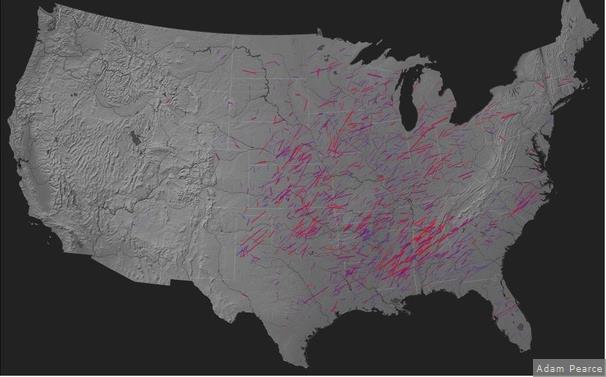
America's Most Violent Tornadoes Since 1950, Seen On One Blustery Map. Here's a clip from a fascinating article at
The Atlantic Cities: "...
The interactive visualization, available here for your geeking-out pleasure, was assembled by New York City technoartist Adam Pearce, who also did that wonderful presentation of 500 years of meteor spottings. Inspired by a similar model
made by John Nelson, Pearce whipped up a map that gives the track and
wind intensity for each of the twisters. While meteorologists have noted
more than 21,000 tornadoes in the past 63 years, only long-lasting ones
that traveled for more than 20 miles are shown here (just under 2,000).
Fatter lines represent more powerful ones, and the tracks are
approximate, as NOAA "only collects start and end locations – tornadoes
do not actually travel in perfectly straight lines," explains Pearce..."
Graphic credit above: Adam Pearce.
Flood Insurance Is A Complex Problem That May Have A Simple Solution.
Let the markets handle this vs. the federal government? Interesting
idea, but what happens if a massive calamity wipes out a few of these
private ventures? Here's a clip from a story at
Insurance News Daily: "...
There
is a solution to the federal program’s problems that is beginning to
gain attention, though it is somewhat unconventional. Some federal
lawmakers argue that private insurers are capable of handling the risks
associated with flood insurance coverage. Large insurance corporations
certainly have the assets to offer coverage in an effective manner, but
have little incentive to do so due to the potential of grievous loss. If
the federal government could provide some degree of financial safety
net for these companies, they may be willing to take on the risks
associated with flood coverage, thereby alleviating some of the strain
burdening the National Flood Insurance Program."
The U.S. Needs To Retire Daylight Savings And Just Have Two Time Zones - One Hour Apart. Quartz has the Op-Ed, here's the intro: "
Daylight
saving time ends Nov. 3, setting off an annual ritual where Americans
(who don’t live in Arizona or Hawaii) and residents of 78 other
countries including Canada (but not Saskatchewan), most of Europe,
Australia and New Zealand turn their clocks back one hour. It’s a
controversial practice that became popular in the 1970s with the intent
of conserving energy. The fall time change feels particularly hard
because we lose another hour of evening daylight, just as the days grow
shorter. It also creates confusion because countries that observe
daylight saving change their clocks on different days..."
America's First All-Electric School Bus Coming To California.
EcoWatch has the story - here's a clip: "
The first all-electric school bus could be picking up California students by 2014. Trans Tech Bus and Motiv Power Systems debuted the bus at the recent 2013 National Association for Pupil Transportation (NAPT) Annual Summit in Grand Rapids, MI. The two companies collaborated on the bus for the Kings Canyon Unified School District in
the San Joaquin Valley of California. “An electric bus can save a
school district about 16 gallons of fuel a day, or around $11,000 in
fuel savings over a year, not to mention maintenance savings,” Trans
Tech President John Phraner said..."
Photo credit above: "
The
Trans Tech/Motiv SST-e all-electric school bus can save a school
district about 16 gallons of fuel a day, or around $11,000, over a year." Photo credit: PRNewsFoto/Motiv Power Systems.
Man Drives Across U.S. In Under 29 Hours. My new hero. But wouldn't it have been easier to fly? Maybe not, come to think of it.
CNN has the details on Cannonball II, a new U.S. record which may stand for a good, long while. Here's an excerpt: "...
Beginning
in 2009, about the time he started working for Lamborghini Atlanta,
Bolian researched cars, routes, moon phases, traffic patterns,
equipment, gas mileage and modifications. He went into preparation mode
about 18 months ago and chose a Mercedes CL55 AMG with 115,000 miles for
the journey. The Benz's gas tank was only 23 gallons, so he added two
22-gallon tanks in the trunk, upping his range to about 800 miles. The
spare tire had to go in the backseat with his spotter, Dan Huang, a
student at Georgia Tech, Bolian's alma mater. To foil the police, he
installed a switch to kill the rear lights and bought two laser jammers
and three radar detectors. He commissioned a radar jammer, but it wasn't
finished in time for the trek..."
Photo credit above: "
Dave
Black, Ed Bolian and Dan Huang pose in front of the car they would use
to attempt to break the record. Bolian is the leader and main driver,
Black acted as the co-driver and Huang was the team's spotter - keeping
an eye on the car's considerable technology while looking out for
obstacles."
Climate Stories....
"First they ignore you, then they laugh at you, then they fight you, then you win." - Ghandi
Climate Change Seen Posing Risk To Food Supplies. Here's an excerpt of a Justin Gillis article at
The New York Times: "...
In
a departure from an earlier assessment, the scientists concluded that
rising temperatures will have some beneficial effects on crops in some
places, but that globally they will make it harder for crops to thrive —
perhaps reducing production over all by as much as 2 percent each
decade for the rest of this century, compared with what it would be
without climate change. And, the scientists say, they are already seeing
the harmful effects in some regions..."
Experts Say Nuclear Power Needed To Slow Warming.
The reason? Renewables are scaling up rapidly, but may not be able to
provide enough energy fast enough to meet global (low-carbon) needs.
Here's a snippet of a story from AP at
KOTA News: "
Some
of the world's top climate scientists say wind and solar energy won't
be enough to head off extreme global warming, and they're asking
environmentalists to support the development of safer nuclear power as
one way to cut fossil fuel pollution. Four scientists who have played a
key role in alerting the public to the dangers of climate change sent
letters Sunday to leading environmental groups and politicians around
the world. The letter, an advance copy of which was given to The
Associated Press, urges a crucial discussion on the role of nuclear
power in fighting climate change...."
Do The Math: Fossil Fuel Investments Add Up To Climate Chaos. Here's an excerpt from an entry at
Huffington Post: "...
Now
more than ever people need to demand that all financial institutions
that we have entrusted with our money and welfare remove their money --
our money -- from investments in the fossil fuel industry. Make no
mistake we are in a battle for the future with the past. The
centuries-old fossil fuel industries have roots deep within our
governments and other institutions. They know their days are numbered,
they know their power is waning, but they will not go silently into the
night. they will not give up their power without a fight. If governments
will not bite the hand that feeds, if they will not free themselves
from corporate sponsorship then we, the citizens, the concerned and
morally driven individuals will have to take a stand. We will have to
make sacrifices to challenge the deadly status quo. This is what history
teaches us..."
Study: Storms Would Submerge Norfolk Naval Station. The Navy is paying attention to rising sea levels, worldwide, as reported in this story at
PilotOnline.com; here's an excerpt: "...
Average
global temperatures have risen 2 degrees since the mid- to late 1800s,
and sea levels have climbed a foot. With melting glaciers and ice
sheets, the trend could speed up. In 2009, Titley compiled data for the
Navy on what climate change means for the service. He was pleasantly
surprised, he said, by how receptive the leadership was. Still, with
costs that likely will climb into the trillions, the challenges of
meeting the threat are formidable. Even if the Navy does little now, it
can use the study findings to plan what needs to be done, said Titley,
who retired from the Navy 13 months ago. "What is our backup if you lose
Norfolk?" he asked. "What's plan B?...."
Photo credit above: "
Retired
Rear Admiral David W. Titley, who led the U.S. Navy's Task Force on
Climate Change, delivers the President's Lecture Series speech at ODU on
Wednesday, Oct. 30, 2013. Titley, who is director of the Center for
Solutions to Weather and Climate Risk at Penn State University, gave a
speech titled "The Evolving Understanding of Climate Risk: The Challenge
that Won't Go Away."
(Steve Earley | The Virginian-Pilot).
New Finding Shows That Climate Change Can Happen In A Geological Instant. This story at
phys.org
made me do a double-take. Remember, we don't know what we don't know.
It's the "unknown unknowns" that worry climate scientists the most.
Tipping points? Sudden swings into a new climate state? At the rate CO2
is building up in the atmosphere anything is possible in the years
ahead. Here's an excerpt: "
Rapid" and "instantaneous" are words
geologists don't use very often. But Rutgers geologists use these exact
terms to describe a climate shift that occurred 55 million years ago. In
a new paper in the Proceedings of the National Academy of Sciences,
Morgan Schaller and James Wright contend that a doubling in carbon
dioxide levels, the surface of the ocean turned acideic in over a period
of weeks or months and global temperatures rose by 5 degrees centigrade
- all in the space of about 13 years. Scientists previously thought
this process happened over 10,000 years..."
Photo credit above: "
Morgan
Schaller, James Wright, and the core sample that helped them understand
what happened - and how fast it happened - 55 million years ago." Credit: James Wright, Rutgers University.
Last Time Arctic Was This Warm Was 120,000 Years Ago. Here's a headline that got my attention. Andrew Freedman has the story at
Climate Central: here's an excerpt: "
Average
summer temperatures in the Eastern Canadian Arctic during the past 100
years are hotter than they have been in at least 44,000 years, and
possibly as long as 120,000 years, according to a new study.
The study of mosses emerging from beneath receding glaciers on Baffin
Island — the world’s fifth-largest island located west of Greenland
— confirms that rapid Arctic warming
has already put parts of the region in new climatic territory. Arctic
warming is transforming the Far North by melting sea and land ice,
speeding spring snowmelt, and acidifying the Arctic Ocean. Arctic
warming may even be redirecting the jet stream in the northern midlatitudes, making some types of extreme weather events more likely in the U.S. and Europe..."
Image credit above: "
Departure
from average of Arctic surface temperatures during the first decade of
the 21st century, as compared to the 1971-2000 average. The map
illustrates that no part of the Arctic experienced cooler-than-average
conditions during this period." Credit: NOAA.
Pacific Ocean Warming At Fastest Rate In 10,000 Years. Here's a clip from Penn State climate scientist Michael Mann at Huffington Post: "Just
how rapid is the current rate of warming of the ocean? There is an
interesting new article by Rosenthal and collaborators in the latest issue
of the journal Science entitled "Pacific Ocean Heat Content During the
Past 10,000 Years" that attempts to address this question. The article
compares current rates of ocean warming with long-term paleoclimatic
evidence from ocean sediments. So how rapid is the ocean warming? Well,
for the Pacific ocean at least, faster than any other time in at least
the past 10,000 years. The study finds, specifically, that (to quote
Columbia University's press release)
the "middle depths [of the Pacific Ocean] have warmed 15 times faster
in the last 60 years than they did during apparent natural warming
cycles in the previous 10,000..."
Study: Northern Hemisphere Summers Now Warmest Of Last 600 Years.
Rawstory.com has the article; here's the intro: "
Summers
in the northern hemisphere are now warmer than at any period in six
centuries, according to climate research published on Wednesday in the
science journal Nature. Harvard University researchers analysing
evidence from Arctic tree rings, ice cores, lake sediments and
thermometer records said recent warm temperature extremes in high
northern latitudes “are unprecedented in the past 600 years” both for
magnitude and frequency. “The summers of 2005, 2007, 2010 and 2011 were
warmer than those of all prior years back to 1400,” they reported..."
Pacific Ocean Warming 15 Times Faster Than Before.
USA Today has the story; here's the introduction: "
Although
the temperature of the Earth's atmosphere may have hit the "pause"
button recently — with little global warming measured over the past few
years — that hasn't been the case with the oceans. In a study out today
in the journal Science, researchers say that the middle depths of a part
of the Pacific Ocean have warmed 15 times faster in the past 60 years
than they did during the previous 10,000 years..."

